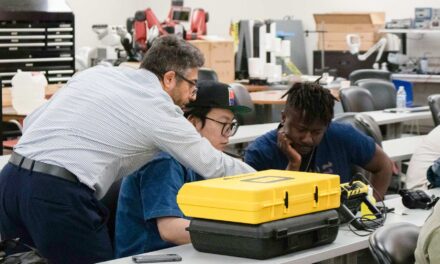
Santos among innovative engineering educators
Posted: November 23, 2010
Fifty-three teachers the National Academy of Engineering considers among “the most innovative young engineering educators” will gather Dec. 13 through 15 in Irvine, Calif., to take part in the Frontiers of Engineering Education symposium.
One is Veronica J. Santos, an assistant professor of mechanical engineering in the School for Engineering of Matter, Transport and Energy, one of the Ira A. Fulton Schools of Engineering at Arizona State University. She’ll join colleagues to explore ideas and methods for more effective teaching.
The national academy is striving to ensure today’s engineering students are being more effectively taught the fundamental concepts and advanced skills needed to become leading engineers and researchers, and are being kept ahead of the curve on ever more rapidly advancing technologies.
Teachers had to be nominated by fellow engineers or a school dean and compete to attend the symposium by submitting a report about their teaching methods.
Santos describes how she teaches the “notoriously challenging” sophomore-level mechanical and aerospace engineering course on the principles of statics and dynamics.
She uses entertaining themed lectures (“Expensive Thrills,” and “Wacky Bicycles” are examples of lecture titles) and hands-on demonstrations (one involves catching water-filled balloons in bed sheets).
She uses videos from Internet websites – including “quirky, but relevant” YouTube videos – that demonstrate applications of engineering principles.
Concepts are also taught through “brain-teaser” riddles, some presented with comic-book style illustrations (one features cartoon characters Bart and Homer Simpson).
In her junior-level course on sensors and controls, students are given remote-control “clickers” they can use to anonymously submit their answers to the riddles during a lesson. Santos finds the electronic devices increase student participation.
She also assembles students into teams to encourage them to collaborate and learn to teach each other.
She gives out candy to students who win competitive exercises she conducts as part of her class lessons. Even with college students, she notes, “candy is a surprisingly good motivator.”
At the symposium, she will present a poster that displays highlights of her teaching methods.
Santos directs the Biomechatronics Lab at ASU, where she leads research in hand biomechanics, neural control of movement, robotics, prosthetics, tactile sensors and clinical applications of biomechanical modeling.
In 2005, she received the Young Investigator Poster Presentation Award from the International Society of Biomechanics, and the same year won the Exceptional Teaching Assistant Award from the Sibley School of Mechanical and Aerospace Engineering at Cornell University (2005).
Earlier this year Santos received support for her robotics work through a National Science Foundation Career Award, which recognizes scientists and engineers in the early stages of their careers who show potential to be leaders and innovators in their fields of expertise.
Santos was nominated to participate in the engineering education symposium by Deirdre Meldrum, dean of the Ira A. Fulton Schools of Engineering. Meldrum served on the National Academy of Engineering committee that did initial planning for the Frontiers of Engineering Education program.
The academy is an independent, nonprofit institution whose members advise government leaders and the public on issues involving engineering and technology.



































